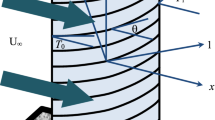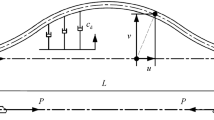Abstract
Non-reciprocal interactions of discrete or continuous systems may induce surprising responses such as flutter instabilities. It is shown in this paper that a finite one-dimensional lattice under non-symmetrical elastic interactions may flutter for sufficiently strong unsymmetrical interactions. An exact solution is presented for the vibration of such one-dimensional lattices with direct and non-symmetrical elastic interactions. An internal force controlling the interactions is included in the model as an additional force for each mass, which acts proportionally to the elongation of a spring at its position. This non-conservative problem due to this circulatory interaction is solved from the resolution of a linear difference equation for this unsymmetrical repetitive lattice. It is possible to derive the exact eigenfrequency dependence with respect to the unsymmetrical interaction parameter, which plays the role of a bifurcation parameter. Divergence and flutter instabilities of this fixed–fixed non-conservative axial lattice under non-Hermitian interactions are theoretically predicted, from a direct approach or by solving the difference equation whatever the number of masses of the lattice. It is shown that the system may flutter for sufficiently strong unsymmetrical interactions, whatever the size of the system, for even or odd number of masses. However, divergence instability may arise in such a system only for even number of masses. The drastic change of response of the present system for odd or even number of particles is specific of the discrete nature of the dynamic system.


Similar content being viewed by others
Data availability
The datasets generated and analyzed during the current study are available from the authors upon reasonable request.
References
Cui, T.J., Li, L., Liu, S., Ma, Q., Zhang, L., Wan, X., Cheng, Q.: Information metamaterial systems. Iscience 23(8), 101403 (2020)
Moscatelli, M., Comi, C., Marigo, J.J.: On the dynamic behaviour of discrete metamaterials: From attenuation to energy localization. Wave Motion 104, 102733 (2021)
Chen, H.T., Padilla, W.J., Zide, J.M., Gossard, A.C., Taylor, A.J., Averitt, R.D.: Active terahertz metamaterial devices. Nature 444(7119), 597–600 (2006)
Chen, X., Feng Ma, H., Ying Zou, X., Xiang Jiang, W., Jun Cui, T.: Three-dimensional broadband and high-directivity lens antenna made of metamaterials. J. Appl. Phys. 110(4), 044904 (2011)
Correas-Serrano, D., Gomez-Diaz, J.S., Sounas, D.L., Hadad, Y., Alvarez-Melcon, A., Alù, A.: Nonreciprocal graphene devices and antennas based on spatiotemporal modulation. IEEE Antennas Wirel. Propag. Lett. 15, 1529–1532 (2015)
Falcone, F., Lopetegi, T., Laso, M.A.G., Baena, J.D., Bonache, J., Beruete, M., Sorolla, M.: Babinet principle applied to the design of metasurfaces and metamaterials. Phys. Rev. Lett. 93(19), 197401 (2004)
Khorasaninejad, M., Chen, W.T., Devlin, R.C., Oh, J., Zhu, A.Y., Capasso, F.: Metalenses at visible wavelengths: diffraction-limited focusing and subwavelength resolution imaging. Science 352(6290), 1190–1194 (2016)
Wu, H., Liu, S., Wan, X., Zhang, L., Wang, D., Li, L., Cui, T.J.: Controlling energy radiations of electromagnetic waves via frequency coding metamaterials. Adv. Sci. 4(9), 1700098 (2017)
Mehmood, M.Q., Mei, S., Hussain, S., Huang, K., Siew, S.Y., Zhang, L., Qiu, C.W.: Visible-frequency metasurface for structuring and spatially multiplexing optical vortices. Adv. Mater. 28(13), 2533–2539 (2016)
Luo, W., Xiao, S., He, Q., Sun, S., Zhou, L.: Photonic spin Hall Effect with nearly 100% efficiency. Adv. Opt. Mater. 3(8), 1102–1108 (2015)
Wang, L., Zhang, Y., Guo, X., Chen, T., Liang, H., Hao, X., Yang, Z.: A review of THz modulators with dynamic tunable metasurfaces. Nanomaterials 9(7), 965 (2019)
Cui, T.J., Qi, M.Q., Wan, X., Zhao, J., Cheng, Q.: Coding metamaterials, digital metamaterials and programmable metamaterials. Light Sci. Appl. 3(10), e218–e218 (2014)
Hadad, Y., Soric, J.C., Alu, A.: Breaking temporal symmetries for emission and absorption. Proc. Natl. Acad. Sci. 113(13), 3471–3475 (2016)
Rosa, M.I., Ruzzene, M.: Dynamics and topology of non-Hermitian elastic lattices with non-local feedback control interactions. New J. Phys. 22(5), 053004 (2020)
Zhou, L., Wang, Q.H., Wang, H., Gong, J.: Dynamical quantum phase transitions in non-Hermitian lattices. Phys. Rev. A 98(2), 022129 (2018)
Torres, L.E.F.: Perspective on topological states of non-Hermitian lattices. J. Phys. Mater. 3(1), 014002 (2019)
Lee, T.E.: Anomalous edge state in a non-Hermitian lattice. Phys. Rev. Lett. 116(13), 133903 (2016)
Bradenbourger, M., Locsin, X., Lerner, E., Coulais, C.: non-reciprocal robotic metamaterials. Nat. Commun. 10, 4608 (2019)
Bordiga, G., Piccolroaz, A., Bigoni, D.: A way to hypo-elastic artificial materials without a strain potential and displaying flutter instability. J. Mech. Phys. Solids 158, 104665 (2022)
Konotop, V.V., Yang, J., Zezyulin, D.A.: Nonlinear waves in PT-symmetric systems. Rev. Mod. Phys. 88(3), 035002 (2016)
El-Ganainy, R., Makris, K.G., Khajavikhan, M., Musslimani, Z.H., Rotter, S., Christodoulides, D.N.: Non-Hermitian physics and PT symmetry. Nat. Phys. 14(1), 11–19 (2018)
Feng, L., El-Ganainy, R., Ge, L.: Non-Hermitian photonics based on parity–time symmetry. Nat. Photon. 11(12), 752–762 (2017)
Miri, M.A., Alù, A.: Exceptional points in optics and photonics. Science 363, eaar7709 (2019). https://doi.org/10.1126/science.aar7709
Malzard, S., Poli, C., Schomerus, H.: Topologically protected defect states in open photonic systems with non-Hermitian charge-conjugation and parity-time symmetry. Phys. Rev. Lett. 115(20), 200402 (2015)
Mochizuki, K., Kim, D., Obuse, H.: Explicit definition of PT symmetry for nonunitary quantum walks with gain and loss. Phys. Rev. A 93(6), 062116 (2016)
Xiao, L., Zhan, X., Bian, Z.H., Wang, K.K., Zhang, X., Wang, X.P., Xue, P.: Observation of topological edge states in parity–time-symmetric quantum walks. Nature Phys. 13(11), 1117–1123 (2017)
St-Jean, P., Goblot, V., Galopin, E., Lemaître, A., Ozawa, T., Le Gratiet, L., Amo, A.: Lasing in topological edge states of a one-dimensional lattice. Nat. Photon. 11(10), 651–656 (2017)
Harari, G., Bandres, M.A., Lumer, Y., Rechtsman, M.C., Chong, Y.D., Khajavikhan, M., Segev, M.: Topological insulator laser: theory. Science 359(6381), eaar4003 (2018)
Bandres, M.A., Wittek, S., Harari, G., Parto, M., Ren, J., Segev, M., Khajavikhan, M.: Topological insulator laser: experiments. Science 359(6381), eaar4005 (2018)
Kozii, V., Fu, L.: Non-Hermitian topological theory of finite-lifetime quasiparticles: prediction of bulk Fermi arc due to exceptional point. (2017) ArXiv preprint arXiv: 1708.05841
Zyuzin, A.A., Zyuzin, A.Y.: Flat band in disorder-driven non-Hermitian Weyl semimetals. Phys. Rev. B 97(4), 041203 (2018)
Yoshida, T., Peters, R., Kawakami, N.: Non-Hermitian perspective of the band structure in heavy-fermion systems. Phys. Rev. B 98(3), 035141 (2018)
Moors, K., Zyuzin, A.A., Zyuzin, A.Y., Tiwari, R.P., Schmidt, T.L.: Disorder-driven exceptional lines and Fermi ribbons in tilted nodal-line semimetals. Phys. Rev. B 99(4), 041116 (2019)
Yoshida, T., Peters, R., Kawakami, N., Hatsugai, Y.: Symmetry-protected exceptional rings in two-dimensional correlated systems with chiral symmetry. Phys. Rev. B 99(12), 121101 (2019)
Hasan, M.Z., Kane, C.L.: Colloquium: topological insulators. Rev. Mod. Phys. 82(4), 3045 (2010)
Qi, X.L., Zhang, S.C.: Topological insulators and superconductors. Rev. Mod. Phys. 83(4), 1057 (2011)
Ryu, S., Schnyder, A.P., Furusaki, A., Ludwig, A.W.: Topological insulators and superconductors: tenfold way and dimensional hierarchy. New J. Phys. 12(6), 065010 (2010)
Freed, D.S., Moore, G.W.: Twisted equivariant matter. In Annales Henri Poincaré, vol. 14, No. 8, pp. 1927–2023. Springer Basel, Basel (2013)
Morimoto, T., Furusaki, A.: Topological classification with additional symmetries from Clifford algebras. Phys. Rev. B 88(12), 125129 (2013)
Shiozaki, K., Sato, M.: Topology of crystalline insulators and superconductors. Phys. Rev. B 90(16), 165114 (2014)
Chiu, C.K., Teo, J.C., Schnyder, A.P., Ryu, S.: Classification of topological quantum matter with symmetries. Rev. Mod. Phys. 88(3), 035005 (2016)
Gomi, K.: Freed-moore k-theory. (2017) ArXiv preprint arXiv: 1705.09134
Yao, S., Song, F., Wang, Z.: Non-Hermitian chern bands. Phys. Rev. Lett. 121(13), 136802 (2018)
Yao, S., Wang, Z.: Edge states and topological invariants of non-Hermitian systems. Phys. Rev. Lett. 121(8), 086803 (2018)
Kunst, F.K., Edvardsson, E., Budich, J.C., Bergholtz, E.J.: Biorthogonal bulk-boundary correspondence in non-Hermitian systems. Phys. Rev. Lett. 121(2), 026808 (2018)
Borgnia, D.S., Kruchkov, A.J., Slager, R.J.: Non-Hermitian boundary modes and topology. Phys. Rev. Lett. 124(5), 056802 (2020)
Yokomizo, K., Murakami, S.: Non-Bloch band theory of non-Hermitian systems. Phys. Rev. Lett. 123(6), 066404 (2019)
Fermi, E., Pasta, P., Ulam, S., Tsingou, M.:Studies of the nonlinear problems (No. LA-1940). Los Alamos National Lab. (LANL), Los Alamos, NM (United States) (1955)
Tarnai, T.: Infinitesimal and finite mechanisms. In: Pellegrino, S. (ed.) Deployable Structures, pp. 13–143. Springer, Wien, New York (2001)
Author information
Authors and Affiliations
Corresponding author
Ethics declarations
Conflict of interest
The authors declare that there is no conflict of interest regarding the publication of this manuscript.
Additional information
Publisher's Note
Springer Nature remains neutral with regard to jurisdictional claims in published maps and institutional affiliations.
Appendix: Analysis of the axial lattice composed of N elements
Appendix: Analysis of the axial lattice composed of N elements
We study the systems shown in Fig.
3, with n = 2, 3, …, 11- composed of n + 1 rigid particles with masses m connected by n + 2 massless springs k to each other (for the symmetrical interaction part). The flutter and the divergence load of the (n-1)-degree-of-freedom discrete non-Hermitian system can be analytically derived. Using Newton's second law, the matrix equation of motion in the absence of external forces for a fixed–fixed BCs is derived in the following general form,
The \(\left[ K \right]\) matrix is not symmetrical due to the effects of unsymmetrical internal forces of the control interactions. The axial natural frequency of the free vibration is computed from the determinant equation:
which can be equivalently presented for the fixed–fixed BCs, and with the assumptions \(\frac{k}{m} = \omega_{0}^{2}\), \(\frac{\omega }{{\omega_{0} }} = \Omega\) and \(\frac{{k_{CI} }}{k} = \alpha\) can be written as follow
The polynomial axial natural frequency relationship is extracted from the expansion of the above determinant in terms of as below
The above equations (a-j) are drawn in Fig.
4 for a fixed–fixed non-Hermitian lattice. Based on the result obtained from the above equation, it is possible to prove the correctness of the general results calculated for divergence and flutter instabilities.
As explained earlier in the paper, flutter instability is calculated by setting \(\Delta = 0\) in the system characteristic equation. Hence, in order to better understand the concept of flutter instability and prove that, in Eq. (44) the results of the discriminant calculation, \({\text{discrim}}\left( {I_{n} ,x} \right),\) were added as follows to some of value n = 3,…, 7 and it was checked that this distinction disappeared, \({\text{eval}}\left\{ {{\text{discrim}}\left( {I_{n} ,x} \right),\alpha } \right\} = 0\) for \(\alpha_{{{\text{flutter}}}} = 1\).
The direct approach derived from the computation of the load–frequency curves based on the mass and the stiffness matrix is equivalent to the method based on the resolution of the difference equation with the n-1 branches of solutions:
Rights and permissions
Springer Nature or its licensor (e.g. a society or other partner) holds exclusive rights to this article under a publishing agreement with the author(s) or other rightsholder(s); author self-archiving of the accepted manuscript version of this article is solely governed by the terms of such publishing agreement and applicable law.
About this article
Cite this article
Massoumi, S., Shakhlavi, S.J., Challamel, N. et al. Divergence and flutter instabilities of a non-conservative axial lattice under non-reciprocal interactions. Arch Appl Mech 94, 187–203 (2024). https://doi.org/10.1007/s00419-023-02515-z
Received:
Accepted:
Published:
Issue Date:
DOI: https://doi.org/10.1007/s00419-023-02515-z







